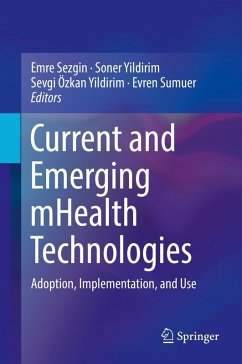
Sustainability in e-Health. Overview and emerging challenges (eBook, PDF)
Sofort per Download lieferbar
Statt: 15,95 €**
13,99 €
inkl. MwSt. und vom Verlag festgesetzt.
**Preis der gedruckten Ausgabe (Broschiertes Buch)
Alle Infos zum eBook verschenkenWeitere Ausgaben:

PAYBACK Punkte
0 °P sammeln!
Seminar paper from the year 2021 in the subject Health - Digital Health Management, grade: 1.7, Lund University (School of Economics and Management), language: English, abstract: Doctor visits and hospital stays are often characterized by inefficient processes, for patients and doctors as well as for hospitals and insurance companies. Enabled by new technologies, many of these processes can be digitized and thus made more efficient, accurate, and sustainable. The purpose of this article is to provide an overview of how e-health services can contribute to greater sustainability through informat...
Seminar paper from the year 2021 in the subject Health - Digital Health Management, grade: 1.7, Lund University (School of Economics and Management), language: English, abstract: Doctor visits and hospital stays are often characterized by inefficient processes, for patients and doctors as well as for hospitals and insurance companies. Enabled by new technologies, many of these processes can be digitized and thus made more efficient, accurate, and sustainable. The purpose of this article is to provide an overview of how e-health services can contribute to greater sustainability through information and communications technology, both for the environment and for society, as well as to identify areas where e-health applications can still be optimized or where new problems arise. Digitization in healthcare continues to permeate all areas. For a long time now, it has not just been about pure telemetry, i.e. electronic communication between the involved parties, but also innovative systems such as the use of machine learning to detect irregularities in X-ray images (Kassania et al., 2021). This is also reflected in the increasing interest of companies and investors in the field of e-health. The amount of annual global investment in the digital health industry has increased from one billion US dollars in 2010 to 21.6 billion in 2020 (StartUp Health, 2021). This was also driven by the huge increase of 55% from 2019 to 2020, due to a very strong interest in e-health solutions during the COVID-19 pandemic (StartUp Health, 2021). E-health solutions offer many advantages for patients, doctors, health insurers, and hospitals. Processes become more efficient through digital communication, patients can receive remote diagnoses via video chat and have digital patient records, and doctors are supported in diagnoses and freed from bureaucratic tasks and can devote more time to their patients. However, due to the continued importance of the healthcare system to society and its long-term planning, consideration must also be given to how e-health can be made as sustainable as possible.
Dieser Download kann aus rechtlichen Gründen nur mit Rechnungsadresse in A, B, BG, CY, CZ, D, DK, EW, E, FIN, F, GR, HR, H, IRL, I, LT, L, LR, M, NL, PL, P, R, S, SLO, SK ausgeliefert werden.













